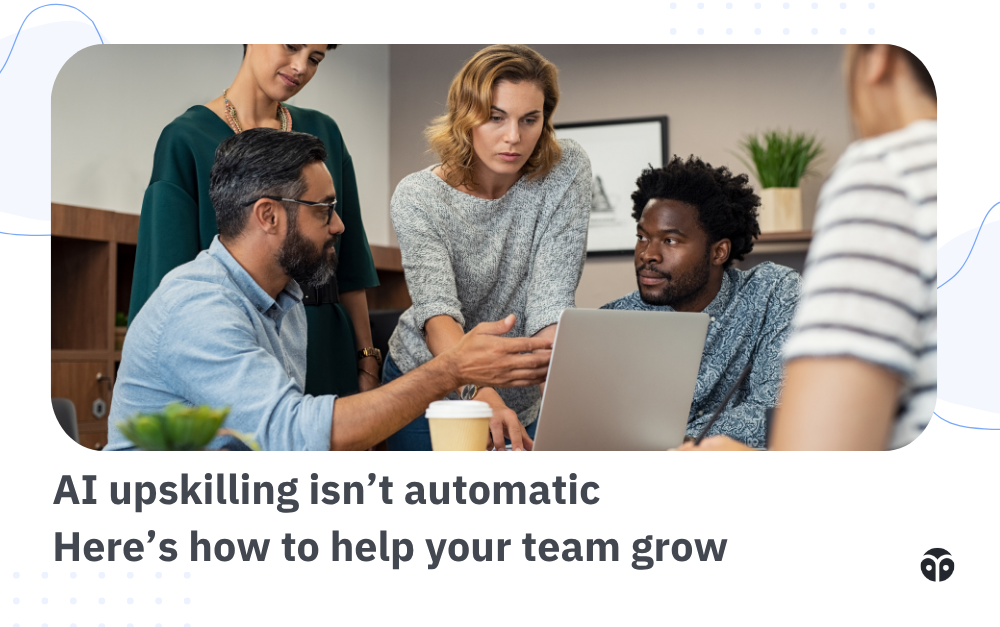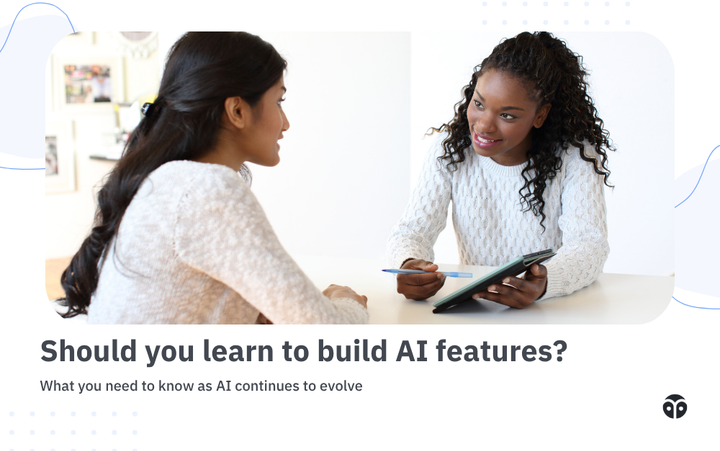AI upskilling isn’t automatic — Here’s how to help your team grow
AI fluency can’t be hired. Here’s how engineering leaders can help their teams learn, adopt, and get real value from AI tools.

By Tala Huhe
Across the industry, engineering leaders are working hard to roll out AI tooling and encourage its adoption. But even in companies investing heavily in AI, usage often remains stubbornly low. The interest is there. The tools are technically available, but the follow-through doesn’t seem to be happening at scale.
It’s tempting to think this is a hiring problem — that what’s missing is a few new engineers who already know how to work with AI. But that assumes a level of expertise that doesn’t really exist yet.
The truth is, no one is an expert in AI implementation. The tools are too new and constantly evolving. What worked six months ago might already feel obsolete. Even engineers who are experimenting regularly are learning in real time, adapting as they go.
If you’re trying to build AI capability by hiring it, you’re likely chasing a moving target.
What’s needed isn’t more people who already know. It’s space for the people you already have to learn.
And that’s not happening automatically.
Why AI adoption lags even when the tools are there
When engineers don’t use AI consistently, it’s often read as hesitation or skepticism. But that misses the point. What many engineering leaders are seeing, and what we've observed in our conversations, is that engineers are often excited to try AI, but they run into practical blockers:
- The tools feel a little too general or too limited to be genuinely useful for complex workflows.
- In large, multi-service codebases, the lack of context in models becomes a blocker.
- For experienced engineers, writing the code yourself can still be faster and more reliable than drafting a prompt, parsing the output, and debugging unexpected side effects.
It’s not that the potential isn’t there. It’s that engineers are good at optimizing for velocity, and unless something clearly saves time or adds value, it won’t stick.
Most teams haven’t built structured paths to AI fluency. There’s a lot of nudging — “try the new tool,” “share your prompts” — but less scaffolding for skill-building. The result is that initial attempts feel clunky, slow, or underwhelming, and engineers give up.
The AI fluency gap and why it’s growing
What makes this moment particularly tricky is that the definition of AI fluency keeps shifting. The field moves fast. Prompting best practices evolve weekly. Tools you became comfortable with six months ago might be obsolete, or dramatically different, today.
So, engineers, especially those who have already had to learn and relearn dozens of frameworks and paradigms over their careers, are weighing the time investment carefully. They want to learn. But they want to invest in skills that will last. And AI, in its current state, doesn’t always feel like a safe bet.
What engineers actually use AI for (when it works)
Still, we’ve seen strong signals of where AI is making an impact. When engineers find low-stakes, high-reward use cases, adoption picks up organically.
Some of those use cases:
- Drafting or rewriting commit messages
- Generating migration scripts or throwaway tooling for one-off tasks
- Refactoring or cleaning up repetitive code sections
- Using AI chat interfaces to reason through architectural choices
- Prompting small UI components from natural language
- Improving error messages or internal tools
These aren’t radical shifts, but they’re sticky. Once engineers see an example that saves time or clears a mental hurdle, they’re more likely to return to the tool next time.
What actually helps engineers build AI fluency
One theme we’ve seen from leaders who are further along in AI adoption: they didn’t leave it to chance.
In roundtables we’ve hosted at Formation, engineering leaders shared the structures they’ve put in place to lower the activation energy for using AI:
- Dedicated hack days or build sprints where AI usage is the focus
- Leadership sharing how they’re personally integrating AI into their workflows
- Internal channels or documents that collect useful prompts and lessons learned
- Space for engineers to share failed attempts
- Timeline flexibility for projects where AI experimentation is encouraged
- Framing AI as an evolving skillset, not a top-down directive
In all of these examples, the common thread is this: people aren’t just told to adopt the tool. They’re invited to explore it, with time, support, and examples.
And that invitation matters. Fluency in AI isn’t something that can be handed over in a deck. It’s built over time — through repeated exposure, safe places to experiment, and peers who are learning alongside you.
AI adoption is change management
Too often, AI initiatives are treated like tooling upgrades: roll it out, write a doc, send a Slack, and hope usage grows.
But this isn’t a new syntax. It’s a new way of thinking. And that requires change management.
That means:
- Creating time and space for experimentation without pressure
- Modeling from trusted peers and managers
- Building recognition and feedback loops around creative use
- Establishing community norms that reward sharing and iteration
Without those elements in place, even the best tools won’t get traction. But when they are present, AI adoption starts to look less like a project and more like a culture shift.
The ripple effects when AI use takes hold
As engineers develop fluency, the benefits compound.
The nature of the work shifts:
- Engineers start to question which tasks are AI-able and which require deeper thinking
- Peer learning accelerates as people post and remix useful prompts
- Small internal improvements (error messages, dev envs, onboarding tools) get built more often
- Engineers start solving different kinds of problems, not just faster, but better
And over time, the organization itself becomes more resilient, because it’s not waiting for a top-down AI strategy. It’s growing its own.
AI fluency isn’t something you hire, it’s something you grow
There’s no shortcut to a more AI-capable team. You can’t hire your way around the learning curve. Even the engineers you bring in will need time to adjust, experiment, and figure out how these tools fit into real workflows.
The good news is AI fluency is learnable. With the right support, engineers build the skill like they’ve built every other one.



